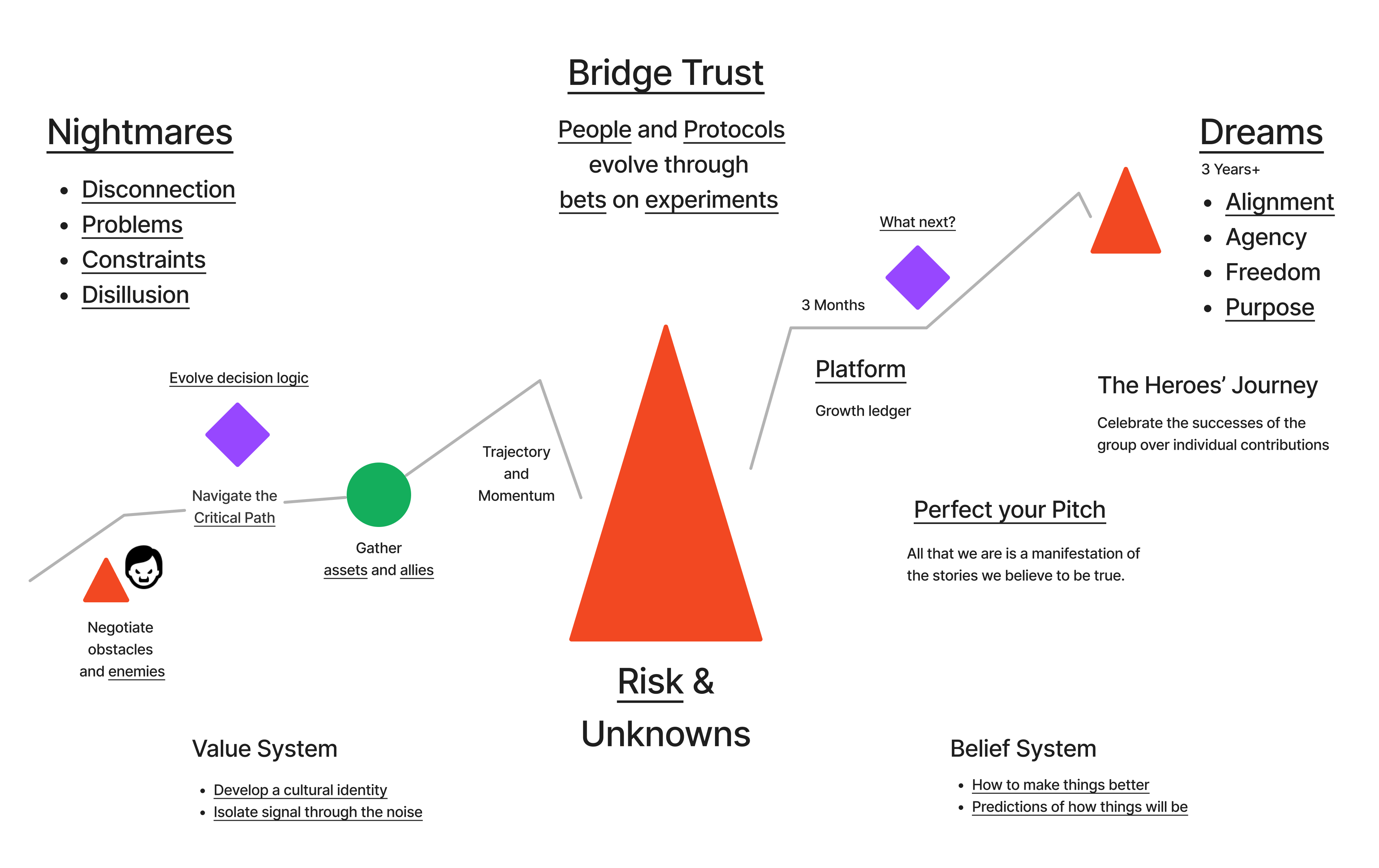Progress
What does success look like—before you achieve it?

Progress is not motion. It's the perceive that builds confidence—a clear picture of the future that makes the path visible and effort meaningful.
If you can build belief, you can shape reality.
Problems
Most people mistake activity for progress. They measure effort instead of distance. The symptoms:
- Busy but not advancing
- Goals achieved but satisfaction absent
- Teams aligned on tasks, confused on outcomes
- Working harder without getting closer
The root cause: No picture of success. Without a clear image of where you're going, every direction feels like progress—and none of it is.
The Ps Build Cs
Progress sits in the middle of the loop. It's the Perceive that enables coordination:
| Perceive | Builds | How |
|---|---|---|
| Progress | Confidence | Clear pictures reduce anxiety about the path |
| Progress | Consensus | Shared pictures enable team alignment |
| Progress | Capital | Visible progress attracts resources |
| Progress | Credibility | Demonstrated progress proves competence |
Without a picture of success, teams argue about tactics. With one, they coordinate naturally.
The Progress Loop
Progress emerges through the loop of consciousness:
[P] PERCEIVE ← Progress lives here
/ \
/ \
[A] ----------- [Q]
ACT QUESTION
Consensus "Are we on track?"
- Perceive the current state and the desired state (the gap)
- Question whether actions are closing the gap
- Act by adjusting course or doubling down
The loop runs continuously. Progress is not a destination—it's the feedback that confirms direction.
The P-C Framework for Progress
| Perceive | Question | Act |
|---|---|---|
| Purpose | Is this aligned with who I am? | Commitment |
| Progress | Are we on track? | Consensus |
| Potential | Is this worth betting on? | Conviction |
Progress asks the trajectory question: Are we on track?
If yes → maintain course. If no → adjust before momentum carries you further off path.
Pictures of Success
Start with the End

The most powerful planning technique: picture the future, then walk backwards.
1. What does success look like? (picture)
↓
2. What artifacts prove success? (evidence)
↓
3. What milestones mark the path? (waypoints)
↓
4. What obstacles must be overcome? (challenges)
↓
5. What's the first step from here? (action)
You cannot hit a target you cannot see.
Maps Over Metrics
Metrics tell you what happened. Maps tell you where you're going.
| Map Type | Shows | Use When |
|---|---|---|
| Outcome Map | Desired end states | Defining success |
| Value Stream Map | Flow of value creation | Finding bottlenecks |
| Dependency Map | What blocks what | Sequencing work |
| Capability Map | Skills and assets | Building teams |
Revisit maps quarterly. The territory changes faster than you think.
The Progress Stack
How inputs become outputs:

Input (Perceive)
- Problems: What is the most important problem you can do something about?
- Predictions: Where is the world going, and where do you need to be?
Belief (Question)
- Perspective: What different viewpoints should you consider?
- Potential: What's possible with current science and imagination?
- Purpose: What's your identity, intention, and values?
Control (Act)
- Platform: What assets, resources, and technology do you have?
- Protocols: How do you use platform to transform the world?
- People: Who improves platform and protocols while delivering value?
- Performance: What outcomes qualify and quantify success?
Value (Output)
- Profits: How much is enough?
- Priorities: What will move the needle?
- Product: What delivers your point of difference?
Building Consensus
Progress without consensus is a solo journey. Progress with consensus is a movement.
The Consensus Ladder
1. Shared perception → We see the same current state
↓
2. Shared picture → We see the same future state
↓
3. Shared path → We agree on how to get there
↓
4. Shared commitment → We're each willing to sacrifice
Most teams fail at step 1. They assume shared perception when they have different realities.
Alignment Signals
| Signal | Meaning |
|---|---|
| "That's not how I see it" | Perception gap |
| "I agree but..." | Picture gap |
| "Let's revisit the plan" | Path gap |
| "I'm not sure I can commit to that" | Commitment gap |
Don't skip levels. Fix perception before arguing about paths.
Measuring Progress
Leading vs Lagging
| Indicator | Type | Examples |
|---|---|---|
| Leading | Predicts future | Actions taken, habits formed, skills built |
| Lagging | Confirms past | Revenue, users, outcomes |
The trap: Measuring only lagging indicators. By the time they move, it's too late to change course.
The fix: Find leading indicators that predict your lagging outcomes.
The Progress Dashboard
What to track:
| Dimension | Question | Indicator |
|---|---|---|
| Direction | Are we heading toward the picture? | Gap closing rate |
| Velocity | Are we moving fast enough? | Milestone completion |
| Efficiency | Are we using resources well? | Output per input |
| Sustainability | Can we maintain this pace? | Team health, burnout |
What Next?
Progress leads to the next perceive:
- Problems — What gaps are we trying to close? → Problems
- Performance — How do we measure success? → Performance
- Priorities — What moves the needle most? → Priorities
- Decisions — What do we commit to? → Decisions
Resources
The success of the journey is all about the people you collect on the way.